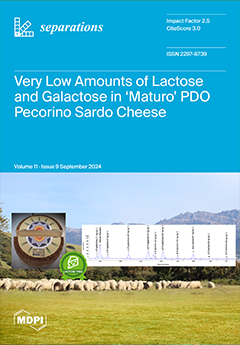In this study, headspace–bar adsorptive microextraction (HS-BAµE) combined with gas chromatography–mass spectrometry (GC-MS) was employed to screen the major biogenic volatile organic compounds (BVOCs) emitted by six different Portuguese shrub species (
Erica scoparia L.,
Cistus ladanifer L.,
Cistus monspeliensis L.,
Lavandula stoechas L.,
Thymus villosus L., and
Thymus camphoratus). The HS-BAµE/GC-MS methodology was developed, optimized, and validated using five common monoterpenoids (α-pinene, β-pinene, limonene, 1,8-cineole, and thymol) and one sesquiterpenoid (caryophyllene oxide). Under optimized experimental conditions (microextraction-sorbent phase: activated carbon (CN1), 3 h (35 °C); back-extraction:
n-C
6 (1 h)), good efficiencies (>45%), low analytical thresholds (5.0–15.0 µg/L) and suitable linear dynamic ranges (20.0–120.0 µg/L,
r2 > 0.9872) were achieved, as well as acceptable intra and inter-day precisions (RSD ≤ 30.1%). Benchmarking the proposed methodology, HS-BAµE(CN1), against the reference methodology, HS-SPME(PDMS/DVB), revealed comparable analytical responses and demonstrated excellent reproducibility. Among the six shrub species studied,
Thymus camphoratus exhibited the highest emissions of BVOCs from its leaves, notably, 1,8-cineole (4136.9 ± 6.3 µg/g), α-pinene (763.9 ± 0.5 µg/g), and β-pinene (259.3 ± 0.5 µg/g). It was also the only species found to release caryophyllene oxide (411.4 ± 0.3 µg/g). The observed levels suggest that these shrub species could potentially serve as fuel sources in the event of forest fires occurring under extreme conditions. In summary, the proposed methodology proved to be a favorable analytical alternative for screening BVOCs in plants. It not only exhibited remarkable performance but also demonstrated user- and eco-friendliness, cost-effectiveness, and ease of implementation.
Full article





